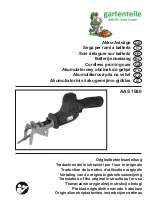
GB
MT
44
Performing Bevel Cuts
(Figure 36)
All bevel cuts are made using the parallel stop (6).
-
Adjust the saw blade (4) to the desired angle.
-
Adjust the parallel stop (6) according to the workpiece width
and height.
-
Perform the cut according to the workpiece width
Performing Transverse Cuts
(Figures 29, 37)
-
Push the transverse stop (40) into one of the two grooves
(33) of the saw table. Adjust to the desired angle. The left
groove (33) is to be used if the saw blade (4) also has to be
positioned at an oblique angle.
This will prevent your hand and the transverse stop from
coming into contact with the saw blade guard.
-
Use the stop rail (39).
-
Press the workpiece irmly against the transverse stop (40).
-
Switch on the saw.
-
Push the transverse stop (40) and workpiece in the direction
of the saw blade in order to perform the cut.
-
Caution: Always hold the guided workpiece irmly and never
the free workpiece which is cut off.
-
Always push the transverse stop (40) so far forwards until the
workpiece is completely cut through.
-
Switch the saw off again. Only remove sawing waste when
the saw blade has come to a standstill.
Cutting Chipboard
In order to prevent the cut edges chipping when the chipboard
is cut, the saw blade (4) should be adjusted so that it is not more
than 5 mm above the thickness of the workpiece.
Collection bag for wood residues
The collection bag is only intended for small wood residues. They
can be collected directly from the saw table to keep it clean and
free from obstructions. Under no circumstances may the wood
residues in the collection bag protrude beyond the collection bag
itself. This would prevent the saw table from being fully usable.
This poses a security risk.
Transport
(Fig. 38/39)
1. Turn the power tool off before it is transported and discon-
nect it from the power supply.
2. Pull off any suction hose, that may be connected, from the
suction adapter (18).
3. Insert the saw blade with the help of the crank handle (12).
By turning the saw blade (4) anticlockwise, it moves
downwards.
4. At least two people should carry the power tool. Do not hold
the power tool by the table width extensions. Please only use
the points as shown in (Fig. 38/39) to transport the
machine.
5. Protect the power tool against knocks, jolts and strong vibra-
tions, e.g. when it is transported in motor vehicles.
6. Secure the power tool against tilting and sliding.
7. Never use the protective devices for handling or transport.
Cleaning and Servicing
Remove the mains plug before carrying out any adjust-
ments, maintenance or repair work.
You should have any repair and maintenance work that is
not described in these instructions carried out by our Ser-
vice Centre. Only use original parts.
Perform the following cleaning and maintenance work regularly.
This guarantees reliable use for a long time.
Cleaning
The device must not be sprayed with water or
placed in water. Otherwise there is a risk of
electric shock.
• Keep the safety devices, air vents and motor housing as free
of dust and dirt as possible. Wipe the device off with a clean
cloth or blow it out with compressed air at a low pressure.
• We recommend that you clean the device immediately after
every use.
• Clean the device regularly with a damp cloth and some soft
soap. Do not use any detergents or solvents; these might attack
the plastic parts of the device. Make sure that no water can get
into the interior of the device.
• Oil the moving parts once a month in order to extend the tool
life. Do not oil the motor.
Storage
• Store the appliance in a dry place well out of reach of
children.
Waste disposal and environmental
protection
Take the batteries out of the device and recycle the device, bat-
teries, accessories and packaging in an environmentally friendly
manner
.
Electrical machines do not belong with domestic waste.
• Dispose of the batteries according to local standards. Hand
in the batteries at a used battery collection point where they
are recycled in an environmentally friendly manner. For more
information, please contact your local waste management
provider or our service centre
.
• Defective units returned to us will be disposed of for free.
Summary of Contents for PTK 2000 D3
Page 5: ...max 3 5 mm 16 18 14 17 19 15 13 38 37 36 18 3 29 31 2 5 28 28 35 a 20 2 5 30 f c e z 5...
Page 62: ...62...
Page 64: ...23 25 21 24 26 22 32 16 p 39 6 h k 6 39 6 m 16 n o 27 28 39 45 m r 6 4 39 6 64...
Page 65: ...31 29 m 33 39 34 36 2 32 33 1 2 6 34 6 2 z 35 36 4 6 40 38 37 35 35 19 30 6 p q 65...
Page 66: ...38 39 37 39 40 66...
Page 67: ...67...
















































